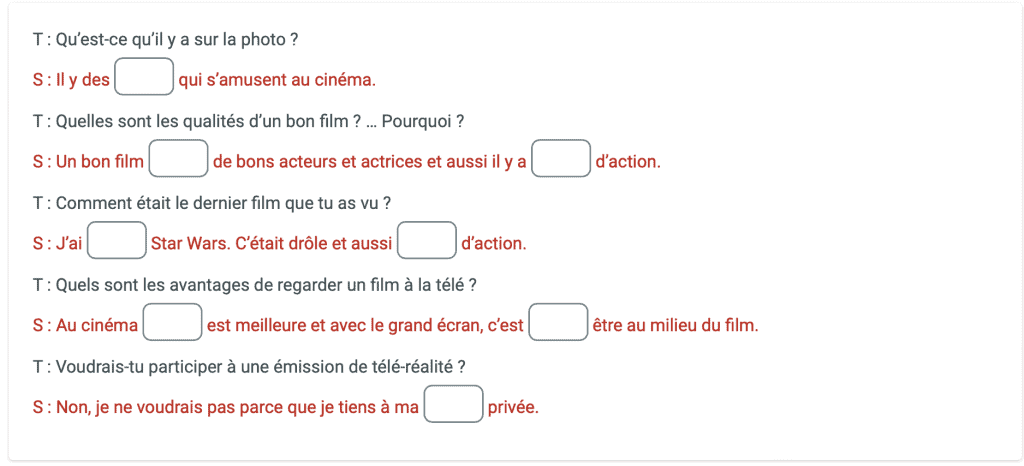Whatever the language being studied, every lesson will include a number of different language teaching activities. These are the core of language teaching and are the medium through which language educators deliver key learning objectives and help students build their skills.
Although every teacher and classroom is different, research in the space has identified three broad types of teaching activity: awareness-raising, skill-getting and skill-using. This blog post looks at each of the three different types and then considers how common teaching activities fit into these criteria.
General aims and objectives of language teaching activities
A review of the literature studying language teaching activities shows that there are three main ways of developing knowledge / skills through the activities that teachers typically deliver in their classrooms. These are:
1. Awareness-raising
Unsurprisingly these activities tend to be delivered at the beginning of a topic or a series of lessons where new materials are being outlined to students. They usually serve to introduce the key points and to begin to engage / excite the learners in the topic and draw on relevant concepts that students have studied previously.
Activities of this type encourage students to think about what’s coming and to brainstorm possible routes forwards. To that end, they can also be useful for teachers in setting the scene for what’s to come and the key points of focus.
2. Skill-getting
Usually managed or presented by the teacher in the first instance, these activities focus on building students’ skills / understanding so that they can achieve a particular learning objective. The educator is therefore positioned front and centre, sharing knowledge with their students.
As a result, these activities are intended to develop students’ accuracy in order to demonstrate that the concept has been fully understood. They are characterised by the use of practice tasks and therefore involve (at least at first) a large amount of scaffolding to get students going.
3. Skill-using
In contrast, skill-using activities put the student at the heart of the learning process and they take the lead in managing their progress. The teacher is typically in a support role, ensuring that the learning environment is fit for purpose.
Students are encouraged to put into practice the skills that they have learned and activities are focused on building fluency. This is usually achieved by putting learners in real-life settings and encouraging them to communicate effectively without much support from the teacher or scaffolded learning materials.
Clearly some lessons will be specifically focused on one of the above types. But it is most likely that educators will include a combination of activities to maintain focus and student motivation.
Common types of language teaching activity
Every language teacher will have a wide range of teaching activities that they call on in lessons. It’s impossible to include all of them all here, but we’re identified six of the main language teaching activities below. We’ve also mapped them to the three core pedagogical purposes identified above.
1. Discussion and debate
This concept is immediately understood and widely used by the majority of language educators. In these activities, pairs or groups of students hold a conversation in their target language in a format set by their teacher.
This could be in the form of a simple “talk to your partner about what you did at the weekend” or a formal debate with motions, speakers and a specific process / rules to follow. However they are used, this type of task is seen as skill-using as students are working with language that they already have / know. Additionally, the talk to your partner format can be easily deployed to get students talking / thinking about a topic when the class starts working on it.
2. Gap filling / Fill-in-the-blank
As the name suggests these tasks require students to identify the right word or piece of information to complete a sentence or piece of text. They are easy for teachers to design and can include any type of text including dialogue.
Importantly the gaps can be filled by testing students’ listening and reading skills. Whilst they also provide an immediate indication of learners’ writing abilities, it is worth bearing in mind that increasing the number and size of gaps in any exercise will also increase the number of potential correct solutions.
As such, these activities tend to be classified as skill-getting as they specifically focus students’ attention and ensure that their understanding is clear / correct.
3. Information-based activities
These activities usually require students to gather / find information from a variety of sources to complete a task. This might see them finding material from their peers, from native speakers or from sources such as libraries or the internet. They typically also involve some form of presentation of the information that has been gathered via a written text or a speech in front of the class.
Therefore these activities are clearly skill-using activities. Students’ listening, reading, speaking and writing skills will be needed to find out the information required and to then report their findings back.
4. Listing and prioritising tasks
Similar in form but slightly different in the skills used, these activities are a great way to engage students in language learning. Listing tasks simply require students to compile a list (e.g. favourite foods, parts of the body etc), whilst prioritising that list gives students an opportunity to explain why X is better, more fun, more engaging than Y.
Depending on the specific execution used by the teacher, listing and prioritising tasks can be effectively used for all three of the broad focuses outlined above. Although much of that will depend on how the educator uses the tasks as a springboard to take learning to the next level.
5. Role play
As with the above, there’s a huge variety of different ways in which language educators can use role plays to engage students. From the completely freeform (Imagine you’re in a restaurant and bump into someone who supports the same football team as you…) to the very specific (You’re a businessman in a hotel in Tokyo when…) there’s a role play for most teaching situations.
Such scenarios can be made even more specific to focus on the use of the particular vocabulary or grammatical concepts that the class has been studying. In this case they can be effectively used as skill-getting activities but are more commonly relevant in skills-using work. In this case, students again have the opportunity to demonstrate the knowledge they have been working on.
6. Skeletons
This form of task has some similarity with a gap-fill exercise as they both involve students completing or updating a piece of content. As the name suggests, the learner is given an incomplete text, or skeleton, and is then asked to complete it, build upon it or respond to it. However, the missing information or gaps tend, in these examples, not to be explicitly signposted.
These activities usually fall into two main types. Firstly expansion exercises where students build on information provided – these are typically skill-getting activities. And secondly activities where students are encouraged to change the ending or imagine an alternative set of circumstances. These can certainly be used as skill-using activities, particularly where students are allowed to be creative in the use of the spoken and / or written language skills.
Whatever language you teach and whatever language teaching and learning activities you use in your classroom, Sanako’s teacher-led language instruction tools include a wealth of unique features that help language educators teach languages more efficiently and more successfully. It’s why the world’s leading educational institutions choose Sanako as their preferred supplier to support online and in-person lesson delivery.
If you are interested in learning more about how Sanako’s software support language teachers and students and would like to see how they could benefit your institution, book a FREE remote demo now to see it in action.



